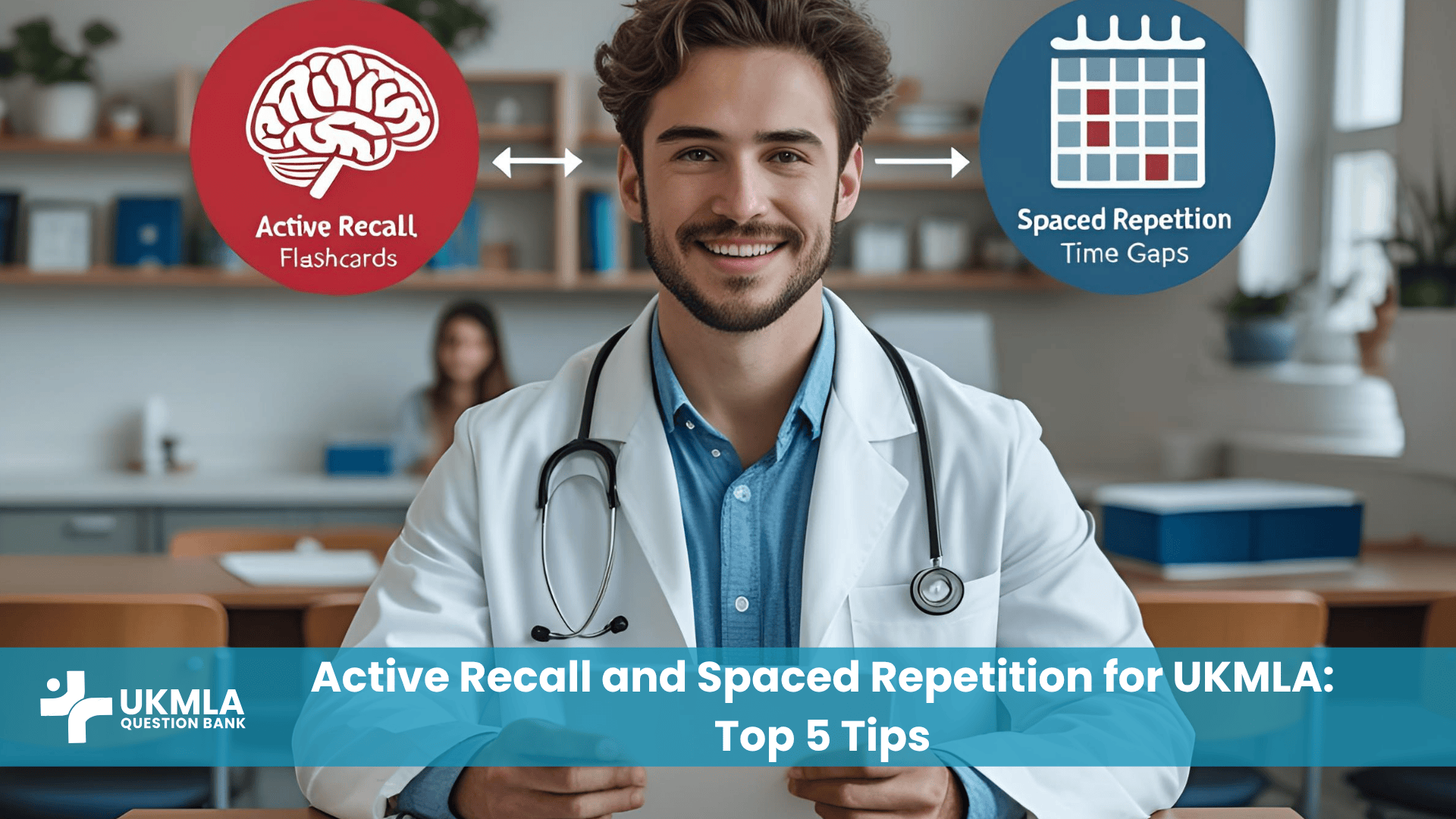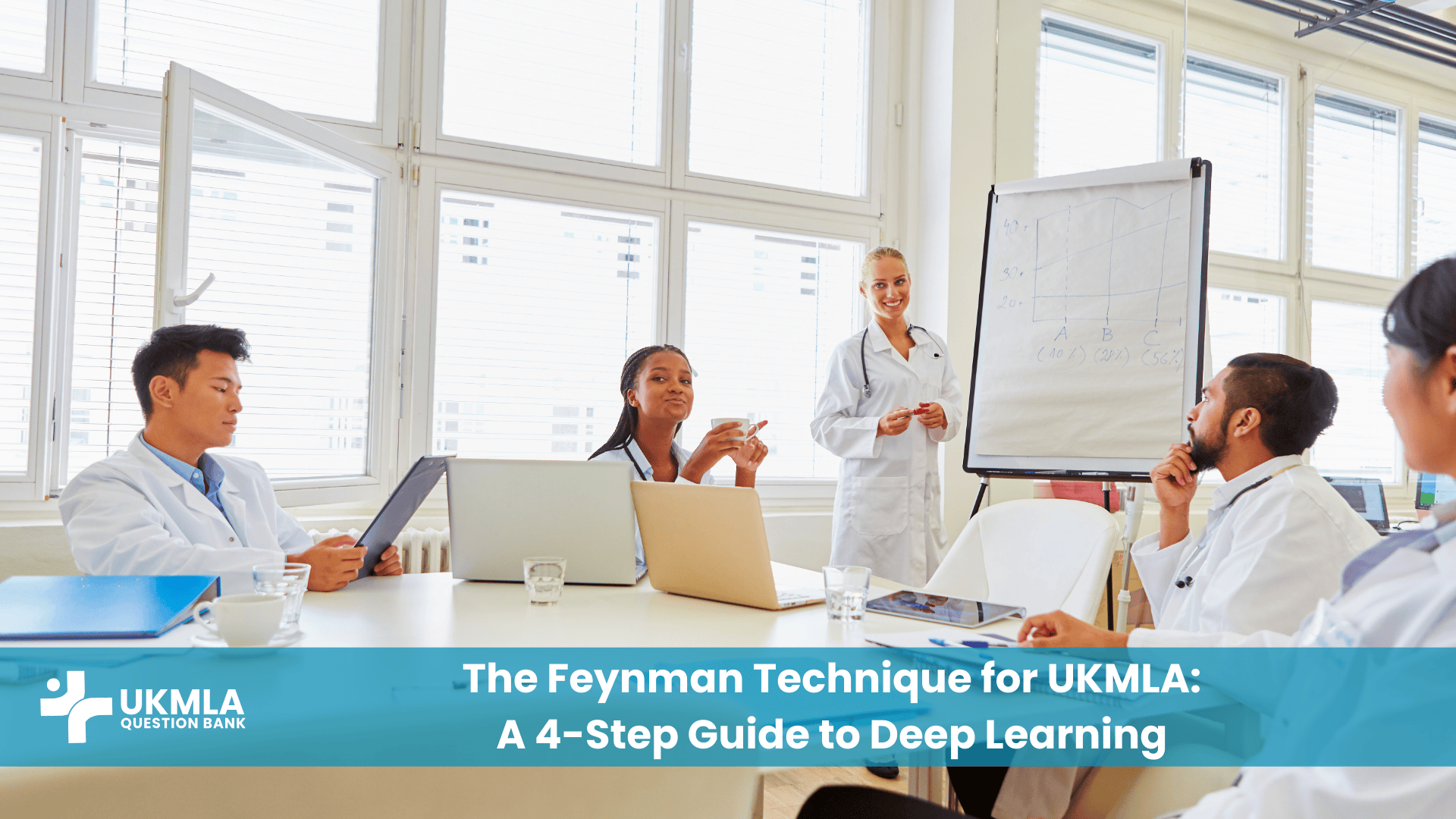For medical students everywhere, the study process can feel like a battle against forgetting. You spend hours diligently re-reading notes, highlighting textbooks until the pages glow, and passively watching lectures. You feel productive, and the material feels familiar. Yet, a week later, when you try to recall the key details of a management pathway, you draw a blank. This frustrating cycle is known as the “illusion of competence,” and understanding how to break it with Active Recall and Spaced Repetition for UKMLA success is paramount.
This is more than just a study tip; it’s about fundamentally changing your approach to learning. The passive techniques that feel comfortable are scientifically proven to be inefficient for the deep, long-term retention required for high-stakes exams like the UKMLA. To succeed, you need to move from being a passive recipient of information to an active participant in your own learning process.
This guide will break down the science behind why your old methods are failing you and provide a practical, 5-tip framework for implementing Active Recall and Spaced Repetition. These two evidence-based pillars of learning science will transform your revision, making it more efficient, effective, and far less stressful.
Key Takeaways
Embrace Effortful Learning: Passive learning like re-reading creates an illusion of competence. True, lasting memory is built through the effortful process of Active Recall.
Beat the Forgetting Curve: Spaced Repetition is the scientifically proven method to interrupt the natural process of forgetting, moving information into your long-term memory.
Your Question Bank is Your Ultimate Tool: A high-quality UKMLA question bank is the single best resource for implementing both Active Recall and Spaced Repetition simultaneously.
Consistency Trumps Intensity: Short, consistent daily sessions using these active techniques are far more effective than long, infrequent cramming sessions.
Shift Your Mindset: The goal is to stop being a passive “information reviewer” and become an active “knowledge retriever.” This is the key to unlocking efficient and effective study.
The Science Behind Effective Learning: Why Your Old Methods are Failing You
Before we dive into the practical tips, it’s crucial to understand why these methods work. The traditional study habits of many students are often at odds with how our brains are actually wired to learn and retain complex information.
The Forgetting Curve: Why We Naturally Forget
In the 19th century, psychologist Hermann Ebbinghaus pioneered the study of memory and discovered what is now known as the “Forgetting Curve.” This curve demonstrates that when we learn new information, our memory of it declines exponentially over time unless we take specific actions to reinforce it. That feeling of a concept “going in one ear and out the other” is a real, measurable phenomenon.
Passive study methods do very little to flatten this curve. When you simply re-read a chapter, you are giving your memory a fleeting, low-impact boost. The curve of forgetting continues its steep downward trajectory almost immediately. This is the natural enemy of your UKMLA revision. The solution is not to study harder, but to interrupt the curve at strategic intervals—a concept we will explore in Tip 2.
The Illusion of Competence: Re-reading vs. Recalling
Why do we stick to inefficient methods like re-reading and highlighting? Because they feel productive. As you re-read a passage, your brain recognizes the information, giving you a satisfying sense of fluency and familiarity. This is the “illusion of competence.” You mistake this ease of recognition for true understanding and mastery.
True learning, however, requires what cognitive scientists call “desirable difficulty.” This is the core principle behind active recall. The mental effort required to retrieve information from your memory without looking at your notes is the very exercise that strengthens the neural pathways for that information.
A Word from a Cognitive Scientist: “The brain is not a recording device; it is a muscle. The act of retrieving information from memory is the exercise that strengthens it. If your learning feels easy and comfortable, it’s often ineffective. True, lasting learning is an effortful process that feels like a struggle, and that struggle is what builds durable knowledge.”
A Practical Guide: 5 Top Tips for Active Recall and Spaced Repetition for UKMLA
Understanding the science is the first step. The next is implementing it. Here are five practical tips to integrate Active Recall and Spaced Repetition for UKMLA preparation into your daily routine.
Tip 1: Make Active Recall Your Default Study Method
From this point forward, your primary goal during a study session should not be to “review” information but to actively retrieve it from your brain. This forces you to engage with the material on a much deeper level.
Here are three powerful ways to practice active recall:
The “Blank Page” Technique: After reading a chapter or watching a lecture on a topic (e.g., the management of asthma), close your books, take out a blank piece of paper, and write down everything you can remember. Draw the management ladder, explain the pathophysiology, list the diagnostic criteria. Only when you can’t recall anything else should you go back to your notes to fill in the gaps.
The Feynman Technique: Try to explain a complex topic in simple terms, as if you were teaching it to a 12-year-old. This forces you to break down the concept to its core components and identify the areas where your own understanding is fuzzy.
Use a UKMLA Question Bank: This is the most powerful and exam-relevant method of all.
Key Point: Answering a question bank question is the ultimate form of active recall. It forces you to not only retrieve knowledge but also apply it to a clinical scenario and make a decision—the very skills the UKMLA assesses. Each question is a targeted, effortful retrieval practice session.
Tip 2: Use Spaced Repetition to Beat the Forgetting Curve
Spaced Repetition is the scientifically proven method for interrupting the Forgetting Curve. It involves reviewing information at increasing intervals over time. For example, you might review a concept 1 day after learning it, then 3 days later, then 1 week later, and so on. This process signals to your brain that the information is important and must be transferred to long-term memory.
Manually tracking these intervals would be impossible. Fortunately, there are two excellent tools for automating this process:
Digital Flashcard Apps (e.g., Anki): These apps use an algorithm to schedule which flashcards you need to review each day. As you get a card right, the app shows it to you less frequently. If you get it wrong, it shows it to you more often.
A High-Quality Question Bank: Many question banks allow you to create custom tests based on questions you have previously answered incorrectly. Regularly completing blocks of your “incorrects” is a perfect, practical application of spaced repetition.
Tip 3: Combine Both Principles with a High-Quality Question Bank
The reason a UKMLA Question Bank: An Essential Resource for Medical Aspirants is so powerful is that it intrinsically combines both principles. Every single question you answer is an act of Active Recall. The feature that allows you to re-do your incorrect answers is a tool for Spaced Repetition.
This combination is the engine of efficient learning. It allows you to simultaneously practice the skill of clinical reasoning while systematically strengthening your memory of the underlying knowledge. A great way to conceptualize this is to transform your old, passive study habits into new, active ones.
Table 1: Transforming Passive Study into Active Study
| Common Passive Technique | Superior Active Counterpart (Active Recall + Spaced Repetition) |
|---|---|
| Re-reading a chapter on Hypertension. | Do a 20-question block on Hypertension. For every incorrect answer, create a flashcard explaining the core learning point and review it with a spaced repetition app. |
| Watching a lecture on Diabetic Ketoacidosis. | After the lecture, use the “Blank Page” method to write out the entire DKA management pathway from memory. Identify gaps and create targeted questions for yourself. |
| Highlighting your notes on Asthma management. | Use the NICE guidelines to create your own flowchart for managing acute asthma from memory. Compare it to the original to check for errors. |
| Passively looking over old flashcards. | Actively test yourself with a block of “incorrect” questions from your Q-bank, forcing your brain to retrieve the information you previously struggled with. |
Tip 4: Build Your Own “Personal Textbook” with Flashcards
Digital flashcard apps are incredibly powerful tools for spaced repetition, but only if you create effective flashcards. Many students make the mistake of creating simple, fact-based cards (e.g., “What is the capital of France?”). This only tests recognition.
To make your flashcards a tool for active recall, follow these principles:
Create them yourself: The act of creating the card is part of the learning process.
Base them on your mistakes: Your most high-yield flashcards will come from your question bank error log. When you get a question wrong due to a knowledge gap, turn that learning point into a flashcard.
Use a “Question and Answer” format: Frame the card as a question that requires you to think, not just recognise a fact. Instead of “Warfarin – MOA,” write “How does Warfarin work, and which pathway does it affect?”
Keep them simple: One core concept per card.
Tip 5: Create a Consistent Study Habit
These powerful techniques have one major prerequisite: consistency. Active recall and spaced repetition work by building and strengthening neural pathways over time. This requires regular, consistent effort.
It is far better to study for 1-2 hours every day using these active methods than to have a single, exhausting 10-hour cramming session once a week. Cramming relies on short-term memory and passive learning—the very things these techniques are designed to overcome. To make this work, you need to build a sustainable study habit. For more on this, see our guide on Creating the Perfect UKMLA Study Plan: A 3-Month Template.
Key Point: Consistency trumps intensity. Studying for 1-2 hours every day using these active methods will build a stronger foundation of knowledge than a single, exhausting 10-hour cramming session.
Table 2: Sample Weekly Active Learning Schedule
| Day | Morning (1 hour) | Afternoon (1 hour) | Evening (30 mins) |
|---|---|---|---|
| Monday | New Q-Bank Block (40 Qs, Timed) | Deep Review & Error Log | Flashcard Review |
| Tuesday | New Q-Bank Block (40 Qs, Timed) | Deep Review & Error Log | Flashcard Review |
| Wednesday | “Weakness” Q-Bank Block (Incorrects) | Review & Identify Gaps | Flashcard Review |
| Thursday | New Q-Bank Block (40 Qs, Timed) | Deep Review & Error Log | Flashcard Review |
| Friday | New Q-Bank Block (40 Qs, Timed) | Deep Review & Error Log | Flashcard Review |
| Saturday | Focused Reading on Weakest Topic | “Blank Page” Summary of Topic | Flashcard Review |
| Sunday | Rest / Light Review | Rest / Plan Next Week | Rest |
Frequently Asked Questions (FAQ) Your UKMLA Study Technique Questions Answered
Digital flashcard apps can seem intimidating at first, but there are many excellent beginner tutorials on YouTube. The key is to start simple: learn how to make a basic “Question and Answer” card and a “Cloze Deletion” (fill-in-the-blank) card. Focus on creating high-quality cards based on your question bank mistakes.
Re-reading can be useful for a very brief, initial overview of a topic you know nothing about. However, it should never be your primary study method. After that initial read, all subsequent interactions with the material should be active.
This is a signal that your understanding of the foundational concept is weak. Don’t just keep trying to memorise the fact. Go back to a primary resource (a textbook or video) and re-learn the topic from the ground up before you try to memorise it again.
This depends on your study phase, but a good rule of thumb is to aim for quality over quantity. Creating 10-20 high-quality flashcards based on your incorrect questions from that day is a very effective and manageable goal.
While pre-made decks can be a good starting point, the process of creating your own cards is a powerful learning exercise in itself. The most effective method is to use a pre-made deck as a base and supplement it with your own cards created from your question bank weaknesses.
Absolutely. You can practice active recall for the CPSA by actively talking through a clinical station out loud, from memory, without looking at a checklist. Then, record yourself or have a friend give you feedback to identify the gaps in your process.
The “Pomodoro Technique” is highly effective. This involves studying with intense focus for a 25-minute block, followed by a 5-minute break. This helps maintain high concentration and prevents burnout during long study days.
The key is consistency, even if the sessions are short. A focused 30-minute session of doing and reviewing 10 questions is far more valuable than doing nothing at all. Try to build a sustainable routine that fits your schedule.
Highlighting itself isn’t inherently bad, but it is a very low-yield, passive activity. It often creates the illusion of learning without any real retention. If you must highlight, use it very sparingly to mark only the absolute most critical information.
For those interested in the cognitive science behind these techniques, the book “Make It Stick: The Science of Successful Learning” by Peter C. Brown, Henry L. Roediger III, and Mark A. McDaniel is an excellent and highly recommended resource.
Conclusion
Success in the UKMLA is not a result of how many hours you study, but how you study. By moving away from inefficient, passive techniques and embracing the scientifically proven power of Active Recall and Spaced Repetition for UKMLA, you are taking control of your learning. This is not about finding a shortcut or an exam “trick”; it is about adopting a more intelligent, evidence-based approach to building durable, long-term knowledge.
This mindset shift—from being a passive reviewer to an active retriever of information—is the single most impactful change you can make to your preparation. These are not just study skills; they are foundational learning principles that will serve you throughout your entire medical career, long after you have passed the UKMLA.
Call to Action:
Now that you understand the science of effective learning, it’s time to put it into practice. Discover how a high-quality question bank is designed to facilitate these techniques by reading our guide on The Best Way to Use UKMLA Question Banks for Maximum Benefit.



